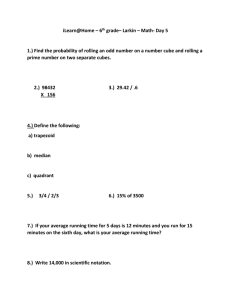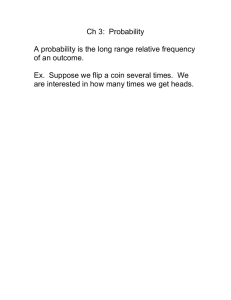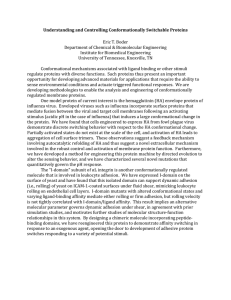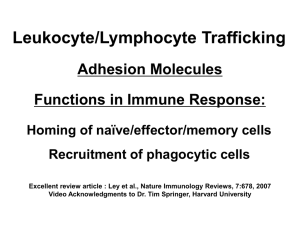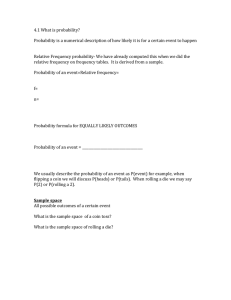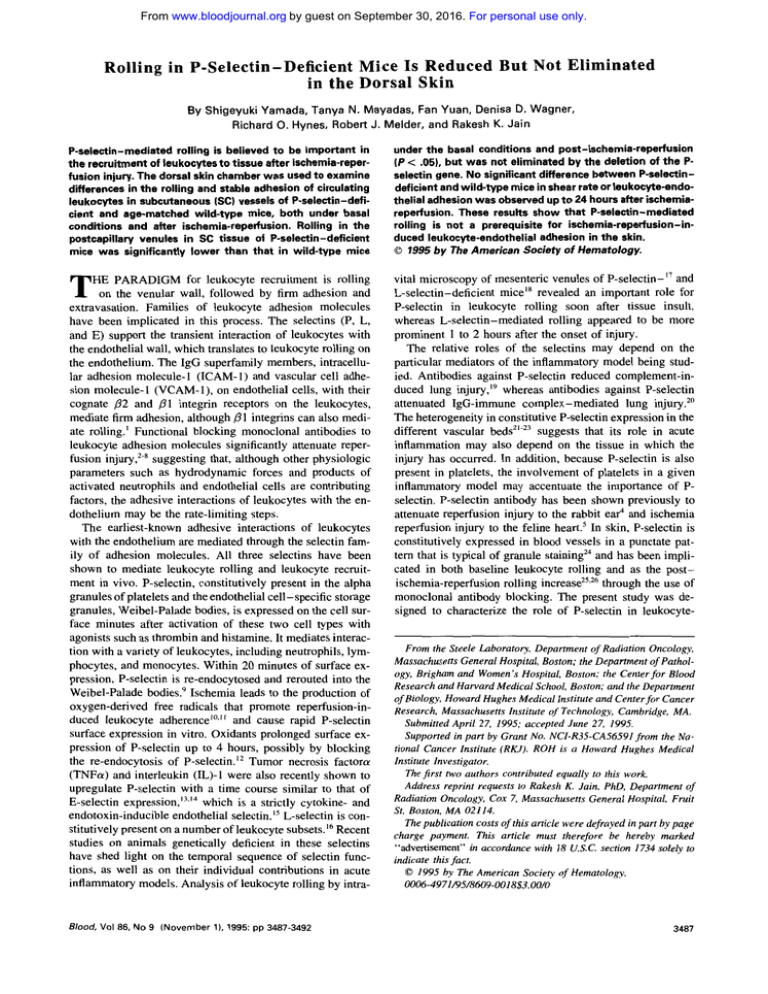
From www.bloodjournal.org by guest on September 30, 2016. For personal use only.
Rolling in P-Selectin-Deficient Mice Is Reduced But Not Eliminated
in the Dorsal Skin
By Shigeyuki Yamada, Tanya N. Mayadas, Fan Yuan, Denisa D. Wagner,
Richard 0. Hynes, Robert J. Melder, and Rakesh K. Jain
P-selectin-mediated rolling is believed to be important in
the recruitment of leukocytesto tissue after ischemia-reperfusion injury.The dorsal skin chamberwas used to examine
differences in the rolling and stable adhesion of circulating
leukocytes in subcutaneous (SC) vessels of P-selectin-deficientandage-matched wild-type mice, both underbasal
conditionsandafterischemia-reperfusion.Rolling
in the
postcapillaryvenules in SC tissueofP-selectin-deficient
mice was significantly lower than that in wild-type mice
under the basal conditions and post-ischemia-reperfusion
( P < .05), but was not eliminated by the deletion of the Pselectin gene. No significant differencebetween P-selectindeficient andwild-type mice in shear rate or leukocyte-endothelia1 adhesionwas observed upto 24 hours after ischemiareperfusion. These results show that P-selectin-mediated
ischemia-reperfusion-inrollingis not aprerequisitefor
duced leukocyte-endothelial adhesionin the skin.
0 1995 by The American Society of Hematology.
T
vital microscopy of mesenteric venules of P-selectin-I7 and
L-selectin-deficient miceI8 revealed an important role for
P-selectin in leukocyte rolling soon after tissue insult,
whereas L-selectin-mediated rolling appeared to be more
prominent 1 to 2 hours after the onset of injury.
The relative roles of the selectins may depend on the
particular mediators of the inflammatory model being studied. Antibodies against P-selectin reduced complement-induced lung injury,” whereas antibodies against P-selectin
attenuated IgG-immune complex-mediated lung injury.’”
The heterogeneity in constitutive P-selectin expression in the
different vascular beds21-23suggests that its role in acute
inflammation may also depend on the tissue in which the
injury has occurred. In addition, because P-selectin is also
present in platelets, the involvement of platelets in a given
inflammatory model may accentuate the importance of Pselectin. P-selectin antibody has been shown previously to
attenuate reperfusion injury to the rabbit ear4 and ischemia
reperfusion injury to the feline heart.’ In skin, P-selectin is
constitutively expressed in blood vessels in a punctate pattern that is typical of granule staining24and has been implicatedinboth baseline leukocyte rolling and as the postischemia-reperfusion rolling i n ~ r e a s ethrough
~ ~ . ~ ~the use of
monoclonal antibody blocking. The present study was designed to characterize the role of P-selectin in leukocyte-
HE PARADIGM for leukocyte recruitment is rolling
on the venular wall, followed by firm adhesion and
extravasation. Families of leukocyte adhesion molecules
have been implicated in this process. The selectins (P, L,
and E) support the transient interaction of leukocytes with
the endothelial wall, which translates to leukocyte rolling on
the endothelium. The IgG superfamily members, intracellular adhesion molecule-l (ICAM-1) and vascular cell adhesion molecule-l (VCAM-l), on endothelial cells, with their
cognate p2 and Dl integrin receptors on the leukocytes,
mediate firm adhesion, although 01 integrins can also mediate rolling.’ Functional blocking monoclonal antibodies to
leukocyte adhesion molecules significantly attenuate reperfusion injury:.’ suggesting that, although other physiologic
parameters such as hydrodynamic forces and products of
activated neutrophils and endothelial cells are contributing
factors, the adhesive interactions of leukocytes with the endothelium may be the rate-limiting steps.
The earliest-known adhesive interactions of leukocytes
with the endothelium are mediated through the selectin familyof adhesion molecules. All three selectins have been
shown to mediate leukocyte rolling and leukocyte recruitment in vivo. P-selectin, constitutively present in the alpha
granules of platelets and the endothelial cell-specific storage
granules, Weibel-Palade bodies, is expressed on the cell surface minutes after activation of these two cell types with
agonists such as thrombin and histamine. It mediates interaction with a variety of leukocytes, including neutrophils, lymphocytes, and monocytes. Within 20 minutes of surface expression, P-selectin is re-endocytosed and rerouted into the
Weibel-Palade bodies.’ Ischemia leads to the production of
oxygen-derived free radicals that promote reperfusion-induced leukocyte adherence”,“ and cause rapid P-selectin
surface expression in vitro. Oxidants prolonged surface expression of P-selectin up to 4 hours, possibly by blocking
the re-endocytosis of P-selectin.I2 Tumor necrosis factora
(TNFa) and interleukin (IL)-l were also recently shown to
upregulate P-selectin with a time course similar to that of
E-selectin expre~sion,”.’~
which is a strictly cytokine- and
endotoxin-inducible endothelial selectin.15 L-selectin is constitutively present on a number of leukocyte subsets.16Recent
studies on animals genetically deficient in these selectins
have shed light on the temporal sequence of selectin functions, as well as on their individual contributions in acute
inflammatory models. Analysis of leukocyte rolling by intra-
Blood, Vol 86,No 9 (November l), 1995:pp 3487-3492
From the Steele Laboratory, Department of Radiation Oncology,
Massachusetts General Hospital, Boston; the Department of Pathology, Brigham and Women’s Hospital, Boston; the Center for Blood
Research and Harvard Medical School, Boston; and the Department
of Biology, Howard Hughes Medical Institute and Centerfor Cancer
Research, Massachusetts Institute of Technology, Cambridge, MA.
Submitted April 27, 1995: accepted June 27, 1995.
Supported in part by Grant No. NCI-R3.5-CA56591from the National Cancer Institute (RKJ). ROH is a Howard Hughes Medical
Institute Investigator.
The first two authors contributed equally to this work.
Address reprint requests to Rakesh K . Jain, PhD, Department of
Radiation Oncology, Cox 7, Massachusetts General Hospital, Fruit
St, Boston, MA 02114.
The publication costs of this article were defrayed in part by page
charge payment. This article must therefore be hereby marked
“advertisement” in accordance with 18 U.S.C. section 1734 solely to
indicate this fact,
0 1995 by The American Society of Hematology.
0006-4971/95/8609-0018$3.00/0
3487
From www.bloodjournal.org by guest on September 30, 2016. For personal use only.
3488
YAMADA ET AL
110
100 -
0
90 -
0
70 60 50 -
80
0
0
0
0
40 0
30 20 10 “
1~”-
0
-U
51
l
P-selectin
deficient
I
Wild
Type
Fig 1. Baseline levels of rolling leukocytes in wild-type and Pselectin-daficient mice. Rolling leukocytes were observed with rhodamine 6G staining under fluorescence illumination. Cells were considered to be rolling if their velocity was less than 40% of the average
RBC velocity. Groups were found to be significantly different IP =
.0015).
endothelial interactions in the dorsal skin fold chamber implanted into P-selectin-deficient mice, both under basal conditions and after ischemia-reperfusion.
MATERIALS AND METHODS
Dorsal skin chamber implantation. Dorsal skin chambers were
implanted into mice according to apreviously described pro~edure,’~
permitting observation of the vessels in the dorsal skin. P-selectindeficient” and age-matched wild-type control mice, weighing 25 to
35 g each, were implanted with chambers and held for a minimum
of 3 days before use in an experiment.
Observation of rolling leukocytes inskin venules. Observations
of blood flow were made without anesthesia. Chamber-bearing mice
were placed into a polycarbonate holding tube to restrict mobility
during observation; placed onto a polycarbonate viewing stage, and
mounted on an intravital microscope (Axioplan; Zeiss, Oberkochen,
Germany) equipped with a fluorescence filter set for rhodamine and
fluorescein isothiocyanate (FITC) (Omega Optical, Inc., Brattleboro,
VT), an intensified CCD video camera (C2400-88; Hamamatsu Photonics KK, Hamamatsu, Japan), aCCD video camera (AVC-D7;
Sony, Tokyo, Japan) and a S-VHS videocassette recorder (SVO9500MD; Sony, Tokyo, Japan).
Each chamber was initially mapped with the 1OX and 20X objectives to select vessels of appropriate size and establish their location
within the chamber relative to the other vessels. A minimum of three
postcapillary venules in the 12- to 3 l-pm size range were selected
for observation in each chamber. Each vessel was observed under
transmitted light for at least l minute to obtain red blood cell (RBC)
velocity data. An injection was then made with a bolus of 50 p L of
0.1% Rhodamine 6G (Molecular Probes, Eugene, OR) in saline into
the tail vein to observe the leukocyte-endothelial interactions. Obser-
vations were made with the 20x objective using the intensitied CCD
camera and were limited to a 30-second period for each vessel.
Dermul ischemiu it1 the dorsal chumher. After the determinatton
of baseline parameters, the dorsal skin was subjected to clamp hypoxia for 4 hours. This was performed with a screw clamp that was
manufactured to tit over the rear of the skin window.””’ As the
clamp was gently closed, a plastic disk covered withthin rubber
cushion compressed the skin against the window, thus restricting
blood Row. The termination ofRow was visually contirmed as the
clamp was tightened, to avoid excess compression of the skin. After
the ischemic period, the clamp was removed, and the chamber was
monitored for blood flow and leukocyte-vascular interactions at 05.
3, 6, and 24 hours after reperfusion.
Anuly.!i.\ of ciclrti. The four-slit technique wasusedto establish
the average RBC velocity in the dorsal skin chamber, with the recorded images obtained with transmitted light” usingthe four-slit
apparatus (MicroFlow System, model 208C, video photometer version; IPM, San Diego, CA) equipped with a personal computer (IBM
PS/2, 4OSX; Boca Raton, FL).
The diameter of the vessels was measured using an image-shearing
device (Model 908, IPM). The shear rates of the observed vessels
were calculated as:wall shear rate = X (average RBC velocity)/
vessel diameter.
Leukocyte-endothelial interactions were quantified according to
the method of Atherton and Born.’x The numbers of rolling (N,) and
adhering (N,) leukocytes were counted for 30 seconds along a 200pm section of vessel. The total flux of cells passing through this
region during that period was also determined (N,). The percent of
rolling leukocytes was defined as 100 X N)(N, + N.J. In a similar
fashion, the density of adherent leukocytes (cells per square milliliter) was determined as [N., x IOh/(.rr x D x 200)], where D isthe
vessel diameter. The Mann-Whitney U test wasused to testthe
statistical significance.
RESULTS
Baseline leukocyte rolling. The postcapillaryvenules of
the dorsal skin showed a high level of baseline rolling. Approximately 68% of observed leukocytes were found to roll
in the postcapillary venules in the dorsal skin of wild-type
mice. In P-selectin-deficient mice, however,baseline rolling
wasreduced to 28% ( P = ,0015; Fig 1). Blood flow rates
and vessel diameters were comparable between P-selectindeficient and wild-typemice; consequently, there was no
significant difference in the shear rates in vessels between
the two groups (Fig 2).
Effects oJ’ ischemia-reperfusion on leukocyte-endothelia1
interactions. Wall shear rate,leukocyterolling, and stable
adhesion measured at0.5,3,6, and 24hours after reperfusion
are shown in Figs 2 to 4. Microvascular diameters did not
change throughout the experiment (data not shown). Also,
RBC velocity and, therefore, wall shear rates didnot signiticantly increase (Fig 2) in either the wild-type or P-selectindeficient group when compared with the preischemic values,
and no significant difference in wall shearratecouldbe
detected between the two groups. At 0.5 hours postreperfusion,leukocyterollinginwild-type
mice was observed to
be over 80% of the total leukocyte flux, but this apparent
increase was not statistically significant whencompared with
the preischemia values (Fig 3). In parallel experiments, ischemia-reperfusion led toa similar profile of leukocyte rolling
in P-selectin-deficient mice (Fig 3). However, the percent-
From www.bloodjournal.org by guest on September 30, 2016. For personal use only.
3489
ROLLING IN P-SELECTIN-DEFICIENT MICE
-1
200
Fig 2. Shoar rates in the dorsalchambervenules
befare tmatmmt (arrows) and after ischemia and r e
perfurion (symbols). There is no significant difference
between pm-iachemia
post-ischemia-mpmfusion
and
(Pz .W)
a
d between wild-type and P-selectin-ddicient mice ( P .m).
l
1
50
0
age of leukocytes rolling in P-selectin-deficient mice remained far below that seen in wild-type animals for all time
points studied ( P < .05).
There was a statistically significant increase in leukocyte
adhesion after reperfusion in both the wild-type mice ( P <
.OS, at time [t] = 30 minutes) and the P-selectin-deficient
mice ( P < .OS, at t = 6 hours), and the number of adhering
leukocytes returned to preischemic levels by 24 hours (Fig
4). On the other hand, leukocyte adhesion was comparable
between wild-type and P-selectin-deficient animals (Fig 4).
DISCUSSION
We report a role for P-selectin in leukocyte rolling under
baseline conditions and after ischemia-reperfusion in the skin
microvasculature. Constitutive leukocyte rolling has been
previously reported in the skin microvasculature of frogz9
and hairless mice.z5.26.30
In the study by Mayr~vitz,~' it
appears that leukocyte rolling occurs in homeostasis, because
the leukocyte rolling was observed in the absence of surgical
5
20
10
15
25
Time (h) post perfusion
trauma. These rolling leukocytes may possibly be part of
the surveillance mechanism in the skin microvasculature,
because this tissue is constantly exposed to external insult.
The adhesion molecules responsible for this rolling are not
known. We now show that baseline rolling is a prominent
feature in the dorsal skin window and that a deficiency in
P-selectin leads to a dramatic decrease in the number of
rolling leukocytes. As P-selectin is constitutively present in
the skin microcirculation," it is plausible that P-selectin on
the endothelium is responsible for supporting the baseline
rolling in the skin. As the skin windows were in place for
several days before intravital microscopy and were used only
if no observable edema had developed during this period,
the baseline rolling may represent the constitutive rolling
pool of leukocytes in the dorsal skin and not the result of
chronic tissue stimulation. Observations of rolling leukocytes in the skin of the ears of C3H and severe combined
immunodeficiency (SCID) mice (our unpublished observations, January 1995) and hairless mice25,26also show high
.
T
*
I
I
1
1-
20
0
15
5
10
Time (h) post-reperfusion
Fig 3. Percent of rolling leukocytes in the dorsal
skin venulesbefore ischemia (arrows) andafter ischemia and repetfusionat 0.5,3,6, and 24 hours (symbok). There is a aignificant difference between wildtype and P-selectin-deficient mice ( P c .W1at each
time point, as indicated by asterisks, but there is no
statisticaldfferenca between proischemia and
postischemia-reperfusion(P> .05) in both the wild-type
and the P-salein-deficient mice.
From www.bloodjournal.org by guest on September 30, 2016. For personal use only.
3490
YAMADA ET AL
' 6mI 1
"
.
I
E l
IP>CICLl,".
N
-A-
T
v1
a
P \d*U111
6
01
0
5
IO
15
Time (h) post-reperfusion
frequency rolling, suggesting that this may be a general property of skin vasculature. The presence of rolling leukocytes
in the skin of P-selectin-deficient mice is unlike that seen
previously in the mesenteric vasculature, where no leukocyte
rolling was observed immediately after exteriorization of the
me~entery.'~
The differential role of P-selectin in these two
tissues may reflect different levels of basal P-selectin expression or the expression of other adhesion molecules. However, the difference may also be due, in part, to the decreased
shear rate present in the skin microvasculature as compared
with the mesentery.3' At lower shear rates, other adhesion
molecules may play a more prominent ro1e.3"33
Ischemia-reperfusion in the dorsal skin led to an insignificant increase in leukocyte rolling (P > .05), but a larger
increase in leukocyte adhesion ( P < .05), suggesting that
the reperfusion-induced increase in leukocyte adhesion was
not solely a consequence of an increase in P-selectin-mediated rolling. Instead, reperfusion appeared to have a dramatic
effect on the number of leukocytes that successfully adhered,
perhaps due to the release of inflammatory mediators that
specifically effect firm adhesion of leukocytes. Ischemiareperfusion is associated with decreased nitric oxide release,
which leads to increased polymorphonuclear leukocyte adheion.'^ Platelet-activating factor (PAF), which plays an important role in mediating leukocyte adhesion after reperfusion of mesenteric venule^,'^ was shown in vivo to increase
the number of adherent leukocytes without affecting the rolling p00l.'~ We have shown that after ischemia-reperfusion
in the mouse skin, leukocyte adhesion and not leukocyte
rolling is the primary parameter affected in both wild-type
and P-selectin-deficient mice. Even though a deficiency in
P-selectin has an effect on leukocyte rolling, it does not
significantly attenuate reperfusion-induced leukocyte adherence in the skin. Our observations also indicate that rolling
and adhesion are not inextricably linked, because lower levels of rolling, as seen in P-selectin-deficient mice, induced
levels of adherent cells that were similar to those in wildtype animals. A similar lack of one-to-one correlation between rolling and firm adhesion has been also reported in
20
25
'
Fig 4. Number of adherent leukocytes per square
millimeter in subcutaneous venulesin the dorsal skin
chamberbeforeischemia
(arrows) andafterischemia-reperfusion at0.5,3,6, and 24 hours (symbols).
There is a statistically significant increase in leukocyte adhesion after ischemia-reperfusionin both the
wild-type mice (P< .05. at t = 30 minutes1 and the
P-selectin-deficient mice ( P < .05, et t = 6 hours),
as indicated by asterisks, and there is no significant
difference between wild-type andP-selectin-deficient mice ( P > .05) at each time point.
thioglycollate-treated mesenteric preparation." A possible
explanation for this phenomenon may be that the levels of
rolling observed is above a threshold value needed for the
full attainment of firm adhesion during the reperfusion period.
It is possible that different leukocyte populations are interacting with the endothelium at different times. The problem
of not being able to identify a subpopulation of leukocytes
is inherent in experiments that use labeling of leukocytes in
vivo. While we can observe the generalized outcome of the
leukocyte interactions, we cannot determine which cell types
are participating in this phenomenon. Hence, the observed
interactions are likely to involve a diverse population of
circulating lymphocytes, monocytes, and granulocytes.
Anti-P-selectin monoclonal antibody has been previously
used to eliminate baseline rolling of leukocytes in the hairless mouse dorsal skin chamber.2s~2h
While our findings are
qualitatively in agreement with these studies, we have found
that deletion of P-selectin expression does not abolish leukocyte rolling, unlike the antibody-blocking studies. These differences may reflect (1) differences in basal expression of
adhesion molecules between mice used in the different studies, ( 2 ) possible compensatory expression of other adhesion
molecules, such as E-selectin or L-selectin ligands or
VCAM, in the skin of the P-selectin-deficient mice,'7,'' or
(3) possible undetected crossreaction or other effects of the
P-selectin monoclonal antibodies used in previous studies.3"
Recent in vitro studies have demonstrated the participation
of 01 integrins in the process of capture and rolling of lymphocytes under physiologic shear s t r e ~ s . ~ ' *As
~ ' ,the
~ ' shear
rates are reduced in the skin compared with the mesentery,
the integrins may be sufficient to support leukocyte rolling
in the skin but notin the mesentery. In addition, basal expression of various adhesion receptors capable of inducing rolling may be different in vessels of the skin and connective
tissue.
These studies have shown that rolling of leukocytes in the
skin venules of P-selectin-deficient mice is reduced when
compared with wild-type control mice, but not eliminated.
From www.bloodjournal.org by guest on September 30, 2016. For personal use only.
ROLLING IN P-SELECTIN-DEFICIENT
MICE
This suggests the contribution of other adhesion molecules
in addition to P-selectin in promoting leukocyte rolling in
this site. Furthermore, increased leukocyte-vascular adhesion
after ischemia-reperfusion injury does not require an increase
in P-selectin-mediated rolling in post-ischemia-reperfusion
injury.
REFERENCES
1, Carlos TM, Harlan JM: Leukocyte-endothelial adhesion mole-
cules. Blood 84:2068, 1994
2. Simpson PJ, Todd RF, Fantone JC, Mickelson JK, Griffin JD,
Lucchesi BR: Reduction of experimental canine myocardial reperfusion injury by a monoclonal antibody (anti-Mol, anti CDIlb) that
inhibits leukocyte adhesion. J Clin Invest 81:624, 1988
3. Vedder NB, Winn RK, Rice CL, Chi EY, Arfors KE, Harlan
JM: A monoclonal antibody to the adherence-promoting leukocyte
glycoprotein, CD18, reduces organ injury and improves survival
from hemorrhagic shock and resuscitation in rabbits. J Clin Invest
81:939, 1988
4. Winn RK, Liggitt D, Vedder NB, Paulson JC, Harlan JM:
Anti-P-selectin monoclonal antibody attenuates reperfusion injury
to the rabbit ear. J Clin Invest 92:2042, 1993
5. Weyrich AS, Ma X,Lefer DJ, Albertine KH, Lefer AM: In vivo
neutralization of P-selectin protects feline heart and endothelium in
myocardial ischemia and reperfusion injury. J Clin Invest 91 :2620,
1993
6. Ma X-L, Tsao PS, Lefer AM: Antibody to CD- 18 exerts endothelial and cardioprotective effects in myocardial ischemia and reperfusion. J Clin Invest 88:1237, 1991
7. Ma X-L, Lefer DJ, Lefer AM, Rothelin R: Coronary endothelialand cardiac protective effects of a monoclonal antibody to
ICAM-I in myocardial ischemia and reperfusion. Circulation
86:937, 1992
8. Ma X-l, Weyrich AS, Lefer DJ, Buerke M, Albertine KH,
Kishimoto TK, Lefer AM: Monoclonal antibody to L-selectin attenuates neutrophil accumulation and protects ischemic reperfused cat
myocardium. Circulation 88:649, 1993
9. Wagner DD: The Weibel-Palade body: The storage granule for
von Willebrand factor and P-selectin. Thromb Haemost 70:105, 1993
IO. Granger DN, Hollwarth ME, Parks DA: Ischemia-reperfusion
injury: Role of oxygen-derived free radicals. Acta Physiol Scand
Suppl 548:47, 1986
11. Granger DN, Benoit JN, Suzuki M, Grisham MB: Leukocyte
adherence to venular endothelium during ischemia-reperfusion. Am
J Physiol 25733683, 1989
12. Patel KD, Zimmerman GA, Prescott SM, McEver RP, McInytre TM: Oxygen radicals induce human endothelial cells to express
GMP-l40 and bind neutrophils. J Cell Biol 122:749, 1991
13. Weller A, Isenmann S, Vestweber D: Cloning of the mouse
endothelial selectins: Expression of both E- and P-selectin is inducible by tumor necrosis factor a.J Biol Chem 267:15176, 1992
14. Hahne M, Jager U, Isenmann S, Hallmann R, Vestweber D:
Five tumor necrosis factor-inducible cell adhesion mechanisms on
the surface of mouse endothelioma cells mediate the binding of
leukocytes. J Cell Biol 121:655, 1993
15. Bevilacqua MP, Nelson RM: Selectins. J Clin Invest 91379,
1993
16. Lasky LA, Rosen SD: Carbohydrate-binding adhesion molecules of the immune system, in Gallin JI, Goldsten IJ, Synderman
R (eds): Inflammation: Basic Principles and Clinical Correlates, second ed. New York, NY, Raven Press, 1992, p 21.1
17. Mayadas TN, Johnson RC, Rayburn H, Hynes RO, Wagner
349 1
DD: Leukocyte rolling and extravasation are severely compromised
in P-selectin-deficient mice. Cell 74:541, 1993
18. Arbones ML, Ord DC, Ley K, Ratech H, Maynard-Curry C,
Otten G, Capon DJ, Tedder TF: Lymphocyte homing and leukocyte
rolling and migration are impaired in L-selectin-deficient mice. Immunity 1:247, 1994
19. Mulligan MS, Polley MJ, Bayer RJ, Nunn MF, Paulson JC,
Ward PA: Neutrophil-dependent acute lung injury: Requirement for
P-selectin (GMP-140). J Clin Invest 90:1600, 1992
20. Mulligan MS, Varani J, Dame MK, Lane CL, Smith CW,
Anderson DC, Ward PA: Role of endothelial-leukocyte adhesion
molecule 1 (ELAM-I) in neutrophil-mediated lung injury in rats. J
Clin Invest 88:1396, 1991
21. McEver RP, Beckstead JH, Moore KL, Marshall-Carlson L,
Bainton DF: GMP-140, a platelet a-granule membrane protein, is
also synthesized by vascular endothelial cells andis localized in
Weibel-Palade bodies. J Clin Invest 84:92, 1989
22. Sanders WE, Wilson RW, Ballantyne CM, Beaudet AL: Molecular cloning and analysis ofin vivo expression of murine Pselectin. Blood 80:795, 1992
23. Dore M, Hawkins HK, Entman ML, Smith CW: Production
of a monoclonal antibody against canine GMP-l40 (P-selectin) and
studies of its vascular distribution in canine tissues. VetPathol
30:213, 1993
24. Symon FA, Walsh GM, Watson SR, Wardlaw AJ: Eosinophil
adhesion to nasal polyp endothelium is P-selectin-dependent. J Exp
Med 180:371, 1994
25. Nolte D, Hecht R, Schmid P, Botzlar A, Menger MD, Neumueller C, Sinowatz F, Vestweber D, Messmer K: Role of Mac-l
and ICAM-I in ischemia-reperfusion injury in a microcirculation
model of Balb/C mice. Am J Physiol 267:H1320, 1994
26. Nolte D, Schmid P, Jager U, Botzlar A, Roesken F, Hecht
R, Uhl E, Messmer K, Vestweber D: Leukocyte rolling in venules
of striated muscle andskin is mediated by P-selectin, not by Lselectin. Am J Physiol 267:H1637, 1994
27. Leunig M, Yuan F, Menger M, Boucher Y, Goetz A, Messmer
K, Jain RK: Angiogenesis, microvascular architechture, microhemodynamics and interstitial fluid pressure during early growth of human
adenocarcinoma LS174T in SCID mice. Cancer Res 52:6553, 1992
28. Atherton A, Born GVR: Quantitative investigations of the
adhesiveness of circulating polymorphonuclear leukocytes to blood
vessel walls. J Physiol (Lond) 222:447, 1972
29. Wagner R: Erlauterungstafeln zur Physiologie und
Entwicklungsgeschichte. Leipzig, Germany, Leopold Voss, I839
30. Mayrovitz HN: Leukocyte rolling: A prominent feature of
venules in intact skin of anesthetized hairless mice. Am J Physiol
262:H157, 1992
31. Melder RJ, Munn LL, Yamada S, Ohkubo C, Jain RK: Selectin and integrin mediated rolling and arrest on TNFa-activated endothelium: Augmentation by erythrocytes. Biophys J (in press)
32. Perry MA, Granger DN: Role of CD1 1/CD18 in shear ratedependent leukocyte-endothelial cell interactions in cat mesenteric
venules. J Clin Invest 87:1798, 1991
33. Gaboury JP, Kubes P: Reductions in physiologic shear rates
lead to CD1 I/CDI 8-dependent selectin-independent leukocyte rolling in vivo. Blood 83:345, 1994
34. Kubes P, Suzuki M, Granger DN: Nitric oxide: An endogenous modulator of leukocyte adhesion. ProcNatlAcad Sci USA
88:465 I , 1991
35. Kubes P, Ibbotson G, Russell J, Wallace JL, Granger DN:
Role of platelet-activating factor in ischemia-reperfusion-induced
leukocyte adherence. Am J Physiol 259:G300, 1990
36. Johnson RC, Mayadas TN, Frenette PS, Mebius RE, Subra-
From www.bloodjournal.org by guest on September 30, 2016. For personal use only.
3492
manium M, Lacasce A, Hynes RO, Wagner DD: Blood cell dynamics
in P-selectin-deficient mice. Blood 86:1106, 1995
37. Routtenberg A: Knockout mouse fault lines. Nature 374:314,
1995
38. Labow MA, Norton CR, Rumberger JM, Lombard-Gillooly
KM, Shuster DJ, Hubbard J, Bertko R, Knaack PA, Terry RW,
Harbison ML, Kontgen F, Stewart CL, McIntyre KW,WillPC,
Bums DK, Wolitzky BA: Characterization of E-selectin-deficient
mice: Demonstration of overlapping function of the endothelial selectins. Immunity 1:709, 1994
YAMADA ET AL
39. BergEL, Fromm C, Melrose J, Tsurushita N: Antibodies
crossreactive withE-and P-selectin blockbothE-and
P-selectin
functions. Blood 85:3 1, 1995
40. Jones DA, Mclntire LV, Smith CW, Picker LJ: A two-step
adhesion cascade for T celVendothelia1 cell interactions under flow
conditions. J Clin Invest 94:2443, 1994
41. Luscinskas W ,Ding H, Lichtman AH: P-selectin and vascular cell adhesion molecule 1 mediate rolling and arrest, respectively,
of CD4+T lymphocytes on tumor necrosis factor-a-activated vascular endothelium under flow. J Exp Med 181: 1179, 1995
From www.bloodjournal.org by guest on September 30, 2016. For personal use only.
1995 86: 3487-3492
Rolling in P-selectin-deficient mice is reduced but not eliminated in
the dorsal skin
S Yamada, TN Mayadas, F Yuan, DD Wagner, RO Hynes, RJ Melder and RK Jain
Updated information and services can be found at:
http://www.bloodjournal.org/content/86/9/3487.full.html
Articles on similar topics can be found in the following Blood collections
Information about reproducing this article in parts or in its entirety may be found online at:
http://www.bloodjournal.org/site/misc/rights.xhtml#repub_requests
Information about ordering reprints may be found online at:
http://www.bloodjournal.org/site/misc/rights.xhtml#reprints
Information about subscriptions and ASH membership may be found online at:
http://www.bloodjournal.org/site/subscriptions/index.xhtml
Blood (print ISSN 0006-4971, online ISSN 1528-0020), is published weekly by the American
Society of Hematology, 2021 L St, NW, Suite 900, Washington DC 20036.
Copyright 2011 by The American Society of Hematology; all rights reserved.

